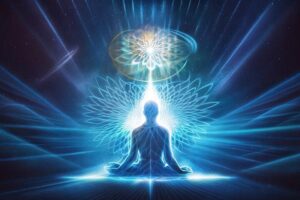Vigyan Bhairava Tantra
Sutra-55

Unveiling the Truth of Dreams and Death Through Meditation – Part 1
Many of us fail to live life in its truest sense. Often, by the time we begin to understand or contemplate the essence of living, we find ourselves confronted with an unexpected illness or, ultimately, death itself. Such individuals are akin to those who amass wealth by any means but fail to truly enjoy its blessings. What purpose does life or wealth serve if we cannot experience it with fullness and meaning?
You might observe that one problem often gives rise to another, prompting a constant pursuit to resolve issues quickly in hopes of avoiding subsequent troubles. Yet, have you realized that the solution to one problem often sows the seeds for the next, ensnaring you in a relentless cycle—a labyrinth of problems and solutions, endlessly recurring?
As long as life exists, challenges will persist. Until we learn to live harmoniously with them, discontent will remain our companion. Thus, resolve what can be addressed and relinquish what cannot. It may happen that, with time, the very problem you abandoned reveals itself as the solution you sought.
Dear friends, there is another pervasive issue—the belief that happiness depends on others. Some lament the absence of the joy or intimacy they once knew, or feel disheartened when their happiness fails to elicit joy in others. When will we truly grasp that our happiness is not tethered to external circumstances?
It is often said that our happiness or bliss is rooted in the mind. However, true joy remains elusive as long as it is sought within the mind’s confines. Indeed, without the mind, one can only feel bliss—never sorrow. The less active the mind, the deeper the sense of joy; when the mind is wholly transcended, one awakens to a state of pure awareness and unbounded ecstasy.
This is why spirituality places profound emphasis on the mind. The mind is both the architect of our troubles and the source of their resolutions. It is the cause of both suffering and joy. Liberation from the mind is the gateway to understanding true bliss and its abode. Even a fleeting moment of such liberation imparts profound insight into how one ought to proceed on the path of life.
You might have heard of concepts like Who Am I, self-realization, or Atma Sakshatkar. Interestingly, these terms have foreign origins and are not inherently born from spiritual traditions. For centuries, we have known our essence and the path to self-awareness. Our spirituality rests upon the knowledge of Who I Am. Moreover, it urges us to transcend this awareness through meditative practices—not by identifying with the self but by becoming a witness. As long as there is an “I,” the mind persists, and with it, every problem and trouble. When the “I” dissolves, the mind dissipates, and a fresh reality unveils itself—a realm entirely anew.
Consider watching a game of cricket or football. As spectators, we feel joy when our supported team wins and sorrow when it loses. Yet, this joy or sorrow is transient, for we experience it as witnesses. The moment we become a member of the team, we assume the “I” and internalize the joy of victory or the pain of defeat far more deeply and enduringly.
This insight teaches us that even as participants, we can maintain the detachment of a spectator. When the “I” is absent, we gain the power to transform our reality. Conversely, as soon as the “I” arises, everything external begins to shape us. Just as some spectators behave like players, clinging to the outcomes, we too often lose ourselves in the illusion of involvement.
The meditative technique outlined here aligns with Sutra 31 but with subtle variations. In Sutra 31, attention is directed to the space slightly above the eyebrows, the tilak point. In Sutra 55, the practice begins with focusing on the Ajna Chakra or the third eye but diverges thereafter. In Sutra 31, initial focus is sustained on the third eye and breath. However, in Sutra 55, the breath takes on a pivotal role throughout.
To practice Sutra 55, sit in Siddhasana or Sukhasana (cross-legged postures). Direct your attention to the tilak point above the eyebrows while maintaining awareness of your breath. This marks the first phase of the technique. You may also shift your focus to the Anahata Chakra (heart center) or Vishuddha Chakra (throat center), integrating breath awareness in the process.
Through this practice, you embark on a journey of profound self-discovery, transcending the limitations of the mind to encounter the infinite and timeless truth of your being.





